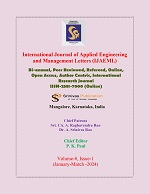Smart LPG Leakage Monitoring and Control System Using Gas Sensor (MQ-X), AWS IoT, and ESP Module
Main Article Content
Abstract
Purpose: Nowadays, LPG is used in almost every kitchen for cooking. It has lots of advantages over other cooking fuels. We need to maintain compliance when we cook using it. The gas flows through a couple of equipment like a regulator, pipe, knob, and burner. If equipment got damaged or the regulator was kept on after cooking, it emitted the gas. This event is dangerous and destructive. So, once it is emitted, it should be detected immediately, and emissions should be stopped. There are several sensors available to detect the gas. We demonstrate using this sensor to build an intelligent gas monitoring system here. When the gas is detected, we regulate the valve and stop the gas emission using the control mechanism.
Design/Methodology: There are two approaches to designing the LPG detector for the researcher. One approach is to create from scratch, using the raw sensor, creating the schematics, and then building the PCB. After that, the components are assembled and tested in a natural environment. Finally, it would be best if we pack within a suitable enclosure. It takes time to make a testable product. The other approach is for rapid prototyping. Here, we followed the fast procedure. To minimize the hardware overhead, we purchased one complete gas detector system, which is available in the market, and then we added our intelligence to it.
Findings/Result: We tested the prototype in a natural environment. The result was found as expected and very promising. We inject the LPG into the sensor. After a couple of seconds, the built-in relay got energized. The ESP module sends the message to the predefined mobile number.
Originality/Value: Several projects have already been done to detect LPG leakage. Most of the project monitors gas; it produces an alarm if leakage happens. But here we added a couple of facilities. One is when gas leakage is detected instantly; it triggers the close of the regulator valve. The second one is the incident time, which will be uploaded to the cloud, not local device memory. It will help for audit purposes. Once a leak is detected, we can send the message to the What’s App. These features provide value to the user.
Type of Paper: Experimental-based Research.
